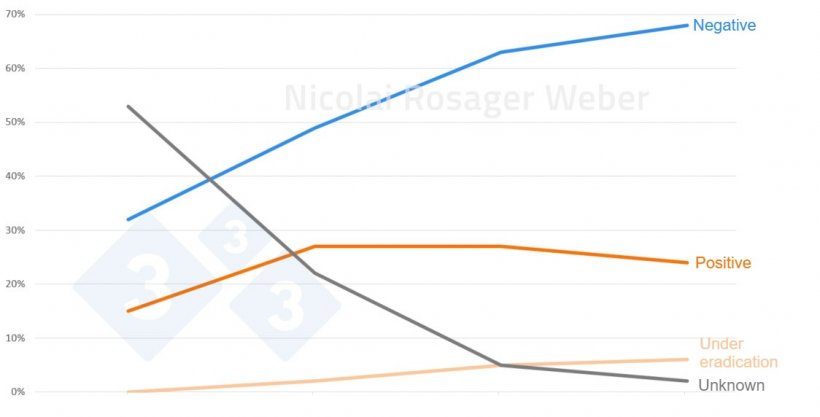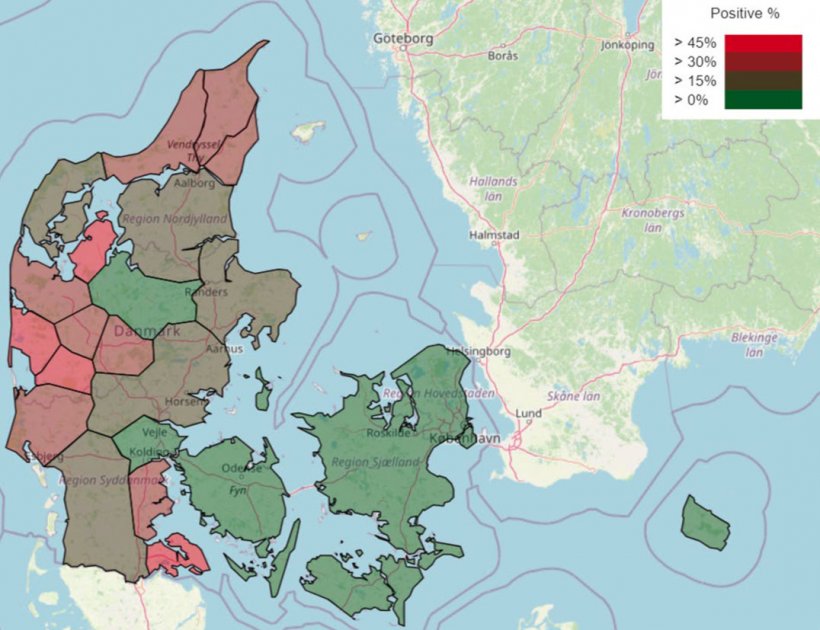The Danish national PRRS (Porcine Reproductive and Respiratory Syndrome) reduction strategy, launched in May 2022, aims to achieve 75% of slaughter pigs from herds with negative PRRS health status and 85% of sow herds with negative PRRS health status by the end of 2025. By January 2025, 68% of all Danish pig herds had a negative PRRS health status, 24% had a positive PRRS health status, and 6% were under eradication. The remaining 2% had an unknown status regarding PRRS.


Based on data from the CHR (Central Herd Register) and SPF database. Includes declaration of both PRRS1 and PRRS2
There is a large variation in the regional distribution of herds with a positive health status with a higher prevalence in the western part of Denmark. PRRS virus can spread locally and through the air, making area-based herd eradication a crucial component of the reduction strategy. Eradication regions have been established based on the geographical location of Danish pig herds, and these regions are continuously adjusted to take local conditions into account. Local PRRS administrators have been appointed and are coordinating the efforts in each region.

As of January 2025, 4,334 herds representing all professional farms in Denmark were covered by the PRRS reduction strategy, as they had at least 10 sows and/or at least 100 pigs in total in the herd. Among these, 89% were in an eradication region. This is a significant increase compared to January 2024, when 54% of all pig herds were in an eradication region. In addition to the initiation of new regions the boundaries of the existing regions were redefined during 2024.
The development of PRRS status in Danish pig herds since January 2022 shows a continuous increase in the proportion of herds with negative PRRS health status, from 32% at the end of 2021 to 68% at the end of 2024. Throughout the whole program all boar stations delivering semen doses have remained negative to PRRS. Nucleus and multiplier herds are frequently tested for PRRS.In case of positive samples the herd are put under restrictions and are being eradicated for PRRS as soon as possible.

The overall infection risk for sow herds decreased compared to previous assessments and was 2.9% per year in 2024, which is more than a halving compared to before the PRRS strategy was implemented.
The infection risk for sow herds has more than halved since the start of the reduction strategy.
PRRS eradications
Two models of PRRS eradication programs are being used at herd level in Denmark:
- Total depop-repop: by definition, total depop-repop eradication of PRRS is always successful.
- Partial eradication with the LCH method (Load, Close, Homogenise) which accounted for 88% of all herd eradication performed in Denmark during 2024 with a succsses rate of 86% of all attempts.
In 2024 the ratio between sow herds completing PRRS eradication and sow herds being infected with PRRS was approximately 3-1 which was equal to the previous years
The Danish PRRS reduction strategy is beginning to show promising results, with an increasing number of sow and finisher herds having negative PRRS health status. New initiatives with declaration of PRRS freedom by county, increased serological surveillance and restriction on movements of pigs with a positive PRRS health status is expected soon to be issued. These new rules along with the other main elements of the strategy including mandatory declaration of the serological PRRS status of all pig herds and a reduced price of PRRS virus-positive pigs at delivery for slaughter will increase the incentive for the eradication of PRRS from the remaining Danish pig herds.
Lessons learned
The first three years of the Danish PRRS reduction strategy have shown that it is possible to control and reduce the prevalence of PRRS in Danish pig production. Good organization with local anchoring is crucial for success. Our eradication models have proven effective, with PRRS-free pigs demonstrating better productivity and lower antibiotic consumption. The entire country is now organized into PRRS reduction regions, and results from the first three years indicate that it is feasible. Area-based eradication can succeed, but it requires careful consideration regarding pig trade and strong local support. Everyone must be involved to achieve success.
The Danish PRRS reduction plans are paving the road for a future national eradication of PRRS from the Danish pig production.




